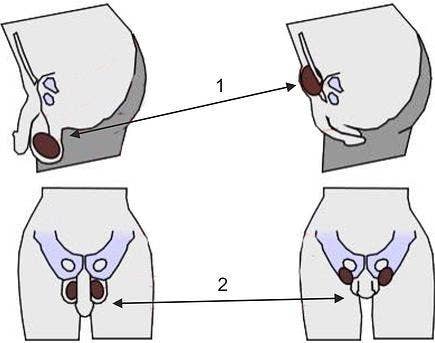So what exactly is tucking?
Tucking is a practice, well-known in both trans and drag circles, of putting one's penis between and behind one's legs, so that it's not visible from the front of the body. Some people push their testicles back as well, while others move them upward and rest them on the lower part of their abdomen before securing them in place.

Why tuck?
There are a number of reasons why trans women tuck: both for our own sense of self, and to influence how others perceive us. For those of us who experience gender dysphoria related to the appearance of our bodies, it's a way for us to feel more like our bodies match the gender we feel inside. Tucking also allows us to navigate spaces more safely in female attire, because being identified as trans can sometimes expose us to harassment and violence. So, come to think of it, tucking is really important for many women.
Is tucking safe?
To answer this question and clear up any misinformation, BuzzFeed consulted Dr. Alexandra Hall, a family physician currently at University of Wisconsin, Stout. She has a decade of experience providing health care for transgender individuals on college campuses, and is often asked to speak at conferences and conduct trainings related to transgender health.
Dr. Hall believes that while there are health risks associated with tucking, they can be avoided with the proper precautions, so trans women can be safe and tucked at the same time.
One major consideration Dr. Hall brings up: Tucking can adversely affect a trans woman's fertility. "The function of the scrotum is to keep the testicles away from the body," she said, noting that sperm should ideally be cooler than people's normal body temperature. "It will decrease sperm quality and quantity, assuming a trans woman is not on hormones."
For trans women who may still want to have biological children someday, Dr. Hall recommends tucking sparingly, or to consider banking their sperm if they can afford it.
Another possible problem that tucking can raise is skin infections. "Where you tuck tends to be a warm and moist area, and a place where we sweat a lot," Dr. Hall said. This leaves trans women who tuck regularly at risk for a superficial fungal infection, commonly known as jock itch.
"In order to avoid skin infections," Dr. Hall said, "you want to keep skin cool and dry. Take a break when you’re alone or wearing a loose flowy skirt when it's not as important to be tucked."
Dr. Hall also recommends over-the-counter anti-fungal powders or creams like Monostat or Nystatin, which are available at any drug store.
Other precautions need to be taken depending on the particular methods people choose to secure their genitals once they're tucked. So before we get to Dr. Hall's specific recommendations, let's review the two major tucking methods, as demonstrated by YouTube lovelies Princess Joules and Brooklyn Beauty.
Tucking Method 1: Tape
In this video, Princess Joules demonstrates how to tuck using tape. First, it's important to shave or wax your pubic hair to prevent pain when pulling the tape out.
Second, she emphasizes that the penis must be soft at the start of the process.
(Well, not literally; Princess Joules points out that the penis should be as soft as overcooked ramen).
Now to the tape: while other tuckers use various types of tape, Princess Joules has one important recommendation:
According to Princess Joules: "Sports tape does the job because it can go on your skin," unlike other tape, which is not designed for skin and can be more painful or irritating.
After wrapping the penis in a piece of tissue paper, Princess Joules suggests taking a long strip of tape and applying it to the penis:
You should leave a long strip to pull back between the legs and up the butt crack. Then, Princess Joules recommends putting a short piece of tape around the penis.
After pulling the long strip of tape back between your legs and up your crack to the small of your back, Princess Joules recommends using two more long pieces of tape to secure the whole business in place.
With this method, Princess Joules is able to go out in form-fitting clothes and even wear bikinis without being worried that her tuck will become undone.
Tucking Method 2: A Gaffe
You may know it as a pretentious word for a mishap or accident, but that's not what Brooklyn Beauty means when she demonstrates her tucking method in this video.
She starts by cutting the elastic top off some pantyhose, then cuts off the top of a sock.


She then puts the sock through the pantyhose elastic, and voila!
She then puts her legs through the gaffe, then tucks her penis between her legs and up her crack before putting the gaffe on.
With this method, Brooklyn is also able to wear tight clothes and swimsuits without being worried about her tuck getting undone.
So which method is better?
The answer is that it depends. Dr. Hall believes that "Taping gives you more control" in terms of giving a really precise appearance and making sure everything remains exactly in place. This is useful for high-stakes situations where a secure tuck is of the essence, or if the exact appearance of that area is something a trans woman is worried about, like if they're wearing a skin-tight dress where their pubic region is highly visible. There's just one problem:
Because taping takes time, and you have to undo and re-do the process every time you pee, people who tape usually don't pee while they're tucked.
According to Dr. Hall, this can lead to a number of problems. "Delayed urination increases your risk of getting a urinary tract infection, though the risk is lower when you have a long urethra," as people with penises do.
And even though there's also a risk of bladder or even kidney damage, Dr. Hall said the likelihood of this is remote because people usually can't voluntarily hold it in long enough for that to happen. However, there's a less severe but more common effect of needing to go for long periods without peeing – dehydration.
"You’re drinking less fluids and you’re walking around dehydrated a lot of the time," Dr. Hall noted about trans women who don't want to pee while they're tucked. "For most people, if you don’t have medical problems your body can handle it. But it can make you more tired, or prone to getting headaches."
Other issues that can develop with taping involve skin reactions. "When you rip the tape off, some of your skin comes with it; that can be irritating over time." Dr. Hall thinks this is a problem even with the use of sports or surgical tape, but she endorses something that our YouTube star also recommends:
Dr. Hall also suggests wrapping the penis either in a baby wash cloth or cutting up underwear, because cotton may be even better for reducing friction and preventing chafing.
So in the end, even though taping provides more control and possibly a more streamlined appearance, using a gaffe is less likely to result in health issues as a result of tucking.
Final Thoughts
So what's a fabulous tucking trans woman to do? Dr. Hall thinks the most sensible solution is to use both methods. "Just do a gaffe most of the time," she recommends, "and then if you really need it, use tape." Remember:
